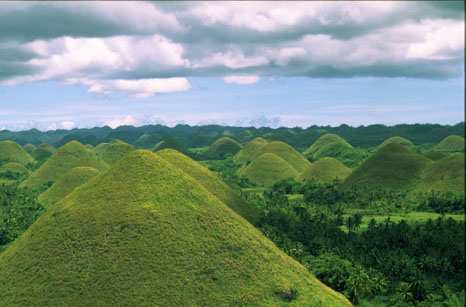
Bohol - The island province lies southeast of Cebu in Central Philippines and is approximately one hour and fifty minutes from Manila. Apart from its world-famous Chocolate Hills as its attraction, Bohol's beauty lies in its unpolluted waters which are rated among the best diving havens in the world and being the home of the world's rarest shells such as the "Gloria maris" and the Golden Cowrie.
Bohol Island is the first province in Asia ever to receive ISO 14001* for environment and ecology. The islands of Panglao, Balicasag and Pamilacan are superb diving spots of the province. In Panglao Island, a popular destination is the Hinagdanan Cave where you will find underground springs. Bohol is also the home of the tarsier, the big-eyed insect-eating monkey whose size is smaller than a boy's fist. Scientists regard the tarsier as the oldest mammal now inhabiting the earth.
Brief Description
Another gem of the Visayas, Bohol’s historical significance extends way back to the blood compact between Boholano Chieftain Sikatuna and the Spanish conquistador, Miguel Lopez de Legaspi, in 1565.
Scenic Bohol casts an enigmatic charm drawn from the many archaic mementos spread throughout the oval-shaped island: from the Chocolate Hills and the tarsier to 16th century watchtowers and Jesuit Baroque mission churches. The Chocolate Hills, all of 1,268 perfectly cone-shaped hills, are undoubtedly the most famous tourist attraction in the province. Among these hills that abound in Central Bohol, two have been developed into top-class resorts.
One of the rare faunas found in the Philippine archipelago, the Tarsier is the smallest primate in the world. It is a nocturnal primate measuring from four to five inches, with a tail that is longer than its body. Those interested in tarsier watching are always welcomed by the Boholanos to see the famous primate in its natural abode up the hills in the town of Corella.
A tropical haven of natural beauty, the coastline of the province is skimmed by gentle coves and white sand beaches. You can find some of the country’s great dive sights here. Balicasag in Bohol is one of the very best and most popular dives in the Visayas. A black coral forest is among its main attractions but virtually anywhere you drop in is sure to be rewarding. Another major attraction, Cabilao is renowned for the hammerhead sharks that shoal around the clear waters. Large pelagics are very common here, and if you are really lucky, you can find yourself swimming with a passing school of dolphins.
Geography
Bohol is about 700 kilometers directly south of Manila and is about 70 kilometers southeast of Mactan Island. The province must have been developed from the magmatic tectonic mechanism which resulted from the underthrusting of the southwest Philippine plate east of Samar and Surigao. The Alicia Schist, the oldest known rock formation in the island, is inferred to be a part of the Bohol crystal rocks before plate interactions. All the succeeding igneous extrusive and intrusive rocks to accumulate were marine and terrestrial deposits in the Bohol basin.
Political Subdivision
The province of Bohol is a first-class A province composed of 47 municipalities and one city, Tagbilaran, which serves as its capital. There are 1,109 barangays with an average household size of 5.4.
Climate
The province falls under the climate type IV characterized by no very pronounced maximum rain period and no dry season. It is usually warm and dry along the coast while cold and humid in the interior. Typhoons are not a frequent occurrence; maximum precipitation occurs in June to October. Average annual temperature is 82 degrees Fahrenheit.
Population
As of the year 2000, Bohol had a population of about 1.137 million growing at an average annual rate of 2.79%. Tagbilaran City is the most densely populated area at more than 2 thousand persons per square kilometer of land. Language / Dialect
The majority speak the native dialect, which is distinctively Boholano. Cebuano, Tagalog, and English are widely spoken and understood.
Major Industries
Bohol is essentially an agricultural province. Its main products are rice, coconut, and corn. The province is fast becoming a tourist destination. It is graciously endowed with natural and historical attractions. Infrastructure projects have supplemented their investment potential. Topping Bohol’s natural tourism assets are the wondrous Chocolate Hills which have drawn thousands of foreign and domestic tourists. These perfectly cone-shaped hills that abound in Central Bohol are the only ones of their kind in the world.

No comments:
Post a Comment